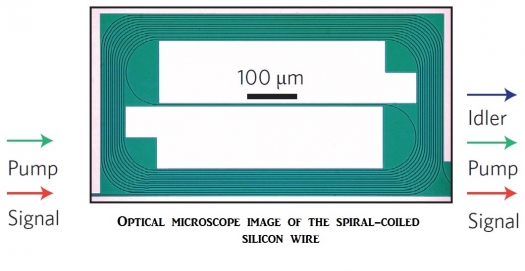News Article
Compact Spectral Translator Improves Mid-IR Optical Systems

INTEC, imec's associated lab at Ghent University has demonstrated efficient up-conversion of mid-infrared signals into the telecom band by means of four-wave mixing in a silicon optical waveguide.
The work was conducted in collaboration with Columbia University and IBM TJ Watson Research Centre (US). With this spectral translator, smaller, lighter and more highly integrated mid-infrared optical systems can be developed for a variety of applications.
This work has recently been published in Nature Photonics. The researchers used efficient four-wave mixing in silicon nanophotonic wires to enable spectral translation of a signal at 2,440nm to the telecom band at 1,620nm, across a span of 62THz. This allows detecting weak mid-infrared signals with uncooled, high-sensitivity, high-speed photodetectors developed for telecommunication applications.
Injection of a mid-infrared input signal with translation to a telecom-band output idler near 1,620nm. The peak on-chip translation efficiency is 19.5dB, and the signal gain is 18.8dB. The transparency bandwidth exceeds 45nm near the idler, and 150nm near the signal
This is a stepping-stone towards the development of high-sensitivity mid-infrared spectroscopic sensing systems fully integrated on a silicon waveguide circuit. Such systems can find applications in industrial and environmental monitoring, threat detection, medical diagnostics and free-space communication.
The 2cm long silicon nanophotonic wire used for spectral translation was fabricated on a 200mm silicon-on-insulator (SOI) wafer at imec, using the multi-project-wafer service ePIXfab . The entire length of the wire is coiled into a compact spiral, occupying an on-chip footprint of only 625µm x 340µm.
The spectral translation of over more than 62THz illustrates that the methodology applied here can be used to efficiently convert optical information on a mid-infrared carrier into the telecom band.
Without such a spectral translator, detection of mid-infrared signals is more difficult. It then relies on the use of narrow-bandgap semiconductors that require cooling for their operation, restricting the development of compact, low-power integrated mid-infrared systems.
The proposed silicon nanophotonic spectral translator, on the contrary, can easily be integrated with the numerous mid-infrared Si components demonstrated to date, including waveguides, vertical grating couplers, microcavities and electro-optic modulators. Altogether, these components have the potential to produce flexible, chip-scale optical systems for mid-infrared applications.
Further details of this work have been published in the paper, "Bridging the mid-infrared-to-telecom gap with silicon nanophotonic spectral translation," by Xiaoping Liu et al in Nature Photonics, 6, 667"“671, (2012). DOI:10.1038/nphoton.2012.221
The result was supported by two European Research Council grants, MIRACLE and InSpectra, and was achieved through a collaboration with Columbia University and IBM TJ Watson Research Centre in New York, USA.
































